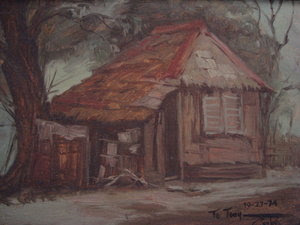 Category: Books
Category: Books Genre: Arts & Photography
Author: Christiane L. de la Paz
Hardbound, 364 pp. Arte de las Islas © 2009 , Limited Edition of 1,000 Copies,with a companion interactive CD
Before I write a review about this book, let me recount how I found it, lost it and finally tracked it down in Greenhills.
I have seen this book in an uppity bookstore in Rockwell, and actually became interested in it upon leafing through a few pages.
When I made a decision to get it, it was gone. The Customer Care guy with a fake, affected English accent checked out other other branches and a copy of the book was confirmed to be available at the Greenhills branch—a long way off from Makati.
When I asked him if it could be delivered to their Makati branch, he answered in the negative, which I found really strange. (I miss the friendliness and efficiency of National Bookstore) . Anyway, he said, there might be a volume available at their EDSA Shangrila branch, which, at least is nearer. He got my contact number, promised to give me a ring, but he never did. A few weeks after, I found myself in the Greenhills area and remembered the book again. I went to the uppity bookstore and tried to look for the book.
The Customer Care person was totally useless with his computer search until another sales aide overheard our talk and budged in—“Is this the 8,000 peso book?”, he asked. I had no idea about the book’s price, but since I’ve seen how thick it was, I just said, “Well, I guess so..” with a shrug of my shoulders.
A few minutes after, he handed me the book, “Private Collections”, same title I remember, but the cover looked different (I would later learn that the book was designed with 12 different covers that you can choose from). It was wrapped in plastic and sealed with tape. I asked permission to open it, but the sales aide hesitated.
Giving me a suspicious stare—I was in my standard shopping outfit: T-shirt, shorts and Islander tsinelas—he told me just to make sure to replace the book on the shelf when I am done with it. “But what if I wanted to buy it?” I asked the aide of this uppity book store (God, I miss National Bookstore!).
This time, he unwrapped the plastic cover for me, I flipped through the pages and recognized the book—and I told him that I will get it. The aide suddenly turned perky, directed me to the cashier and chirpily asked if I wanted to have the book covered with plastic—“it’s an expensive book, sir” (I know that, dum-dum!) , and besides, it’s free! (Thanks, ha?) . So much for uppity book stores and their bourgeoise-acting, fake English speaking staff. And now the book—Private Collections.
The title itself is self-explanatory—it is a coffee table book that features the finest and choices art collections of the most outstanding collectors in the country—classified as Early Career (Julius Babao, Charlie Conjuangco, Mikee and Sheila Romero, Patrick Reyno, etc), Mid-Career (Napoleon Abueva, Manny Zialcita, Gilbert Santos, Louie Ojeda, etc) and End Career Collectors (Washington Sycip, David Consunji, Hans Sy, Joey de Leon, etc.).
Hmm, I just wonder where Paulino and Hetty Que, Jaime Laya and Dr. Teyet Pascual are. I really don’t care much about the opening chapter ( “Collecting, Collectors and Collections”—Is definition of terms truly necessary? Nahhh! There is even a section on “Motivations and Rewards of Collecting”, which touches on our psychological need to collect—read: a sense of pride and ownership. Huh? ).
But once past that, the book engages the eye, each page a virtual gallery of masterpieces, beautifully photographed and with interesting background write-ups about the collector, his collecting interests, accounts of how he started and how his collection was built over time. There is not a single piece of artwork I did not like in the book, even if I am partial to mid-century genre paintings.
But I went agog over the collection of Jose Maria Esteban, which includes an eclectic mix of period and modern pieces, realist paintings as well as abstracts. Julius Babao’s contemporary art collection was also awesome, with the works of Mark Justiniani and Ronald Ventura as highlights.
The Romero couple has outstanding Amorsolos in their collection, plus Simon Flores sacred paintings, Juan Arellanos, Jorge Pinedas, Domingo Celis and Isidro Anchetas—my cup of tea! Oh, to be young and rich—that’s what the Romeros are. Of course, I will never laugh at Joey de Leon again (Kiukoks galore!) and giggle at Orestes Ojeda—I never knew him as an art connoisseur but as a hunky star of sexy movies back in the late 70s.
I still have to try the interactive CD because I am not even done with the book yet—I have about 150 pages to go. In my lifetime, I don’t think I can even get to one tenth of the level reached by these passionate and, more importantly, moneyed collectors (I think you can buy taste with money, no?). For now I will be content with what I have, and will continue to drool over these private collections, happy and hopeful with the thought that in my next trip to Bangkal, I will find the one masterpiece that will become the jewel of my own private collection!





















































